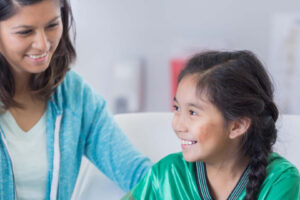Perhaps one of the most difficult tasks as a parent is consoling a child who’s being bullied at school. But what if your child is the bully?
More than half of all children experience some form of bullying during their educational careers. Bullying is defined as any situation where there’s a power differential between two people, and one is trying to take advantage of that perceived inequity. It often involves negative comments about an identifying characteristic of the victim, such as age, size, gender, sexuality, appearance or socioeconomic status. This behavior tends to peak in middle school, but can happen at any time – and at any age.
‘Not My Child’: What to Do if Your Child Is the Bully
If your child has been identified as the aggressor:
- Listen to all sides to gain a clear understanding of what’s going on
- Ask what your child is specifically saying or doing, and get his or her specific account of the situation
- Spend more time with your child to get a better understanding of why he’s targeting the other child
- Hold your child accountable for his or her role in the situation
- Develop clear, consistent rules and expectations about how your child should conduct himself and treat others
- Build on your child’s strengths and encourage him or her to work on those positive traits
- Model the behavior and character traits that you’d like to see in your child
Is Your Child Being Bullied?
If your child is being bullied, talk with him or her to learn more about the specific situation. We use the term “bullying” often, but we need to be more specific about the behavior.
The signs that your child may be being harassed include:
· Acting out of character
· Avoiding school, which may be associated with new physical complaints with no clear medical cause
· Unusual eating or sleeping patterns
· A sudden drop in grades
· Missing items, like lunch money or small valuables
New Methods for Bullying
In the past, opportunities to bully were limited to face-to-face interactions, so children had a reprieve after school hours. However, with social media, texting and multiplayer video games, a bullied child never gets a break from negative interactions with other children that may be potentially detrimental or harmful; he or she is a victim inside and outside of school.
To monitor your child’s use of technology:
- Make it difficult for her to access social media apps like Facebook, Instagram and Snapchat while alone
- Consider moving her computer to a common area in your house
- Consider restricting use of smartphones and other portable technological devices in the home
- Limit mobile phone and tablet use to a reasonable amount of time
- Consider screen time as a privilege that’s earned once homework or household tasks are completed and desired behaviors are consistently maintained
- Know what video games your child is playing and who he or she is playing with
Tips for Besting a Bully
The most important advice for a child who’s being intimidated is to help them to develop assertiveness skills. This includes standing up for their convictions and beliefs, and ignoring and “tuning out” negativity directed toward them. Recommendations to address bullying include:
- Avoid being alone with the bully; always walk with a friend, parent or teacher
- Help children who are being bullied work on their assertiveness skills. Role playing exercises can help children take a stand against an aggressor. Practice specifically what to say and do in situations when someone is antagonizing them. Practice and discuss what to do if a confrontation gets physical, including when to get help from an adult. The goal is to play through several scenarios to provide a dialog to prevent the situation from escalating.
- Help the child express his or her emotions and perspectives in a clear and concise manner
- Identify adults and authority figures who can effectively intervene in a manner that’s not detrimental to any of the children involved
What Doesn’t Work When Addressing Bullying
- Putting the involved individuals in the same room with staff
- A “No Tolerance” policy that doesn’t allow for open dialogue and thorough investigation of the situation. Also, it’s important to recognize how to assess a potential conflict and determine whether there’s a genuine concern and not just typical interpersonal interactions for this age group.
- Telling children to report bullying, particularly in middle school and high school. The key is to identify teaching staff and administrators who can successfully assess a potential conflict.
In a local school where I provide behavioral health treatment services and counseling, we use mediation for preteens in grades four through six. At this age, children are starting to learn about interacting with their peers, and mediation can be very effective when conflicts arise. The most important factor in a mediation is that it has to be mutually agreeable to the children involved in the conflict.
For example, a fifth grader who was on the receiving end of negativity from several other classmates had been responding with additional negativity and anger. Mediation allowed the kids to talk to each other constructively and iron out their issues. An adult supervised the sessions, and the relationships among all students involved improved. These skills can set the stage for how students handle future conflicts as well.
Contact your child’s guidance counselor or the school’s antibullying specialists to learn what programs are available, such as onsite mediation and conflict resolution services. Many schools have implemented evidence-based antibullying programs like Stop Bullying (https://www.stopbullying.gov/), Second Step (https://www.secondstep.org/bullying-prevention) and Do Something (https://www.dosomething.org/us) that teach kids how to gauge their emotions, express themselves socially and respond to episodes of bullying that they observe as bystanders.
If your child is the victim, encourage him to talk about it to avoid escalation, and if you fear that he will harm himself or others, enlist the help of a behavioral health specialist immediately. Your child may benefit from a behavioral health assessment and specialized treatment, including therapy (either group or individual) and counseling for anxiety and anger management.
Whether your child is the victim or the aggressor, the key is to be involved in his day-to-day activities to better understand the stresses and fears he may have. The path to preventing bullying – from either perspective – starts with the first conversation.
Ankur Desai Ankur Desai, MD, is a board-certified child and adolescent psychiatrist on staff at CentraState Medical Center in Freehold. He can be reached by calling 866-CENTRA7.
Ankur Desai, MD, is a board-certified child and adolescent psychiatrist on staff at CentraState Medical Center in Freehold. He can be reached by calling 866-CENTRA7.





